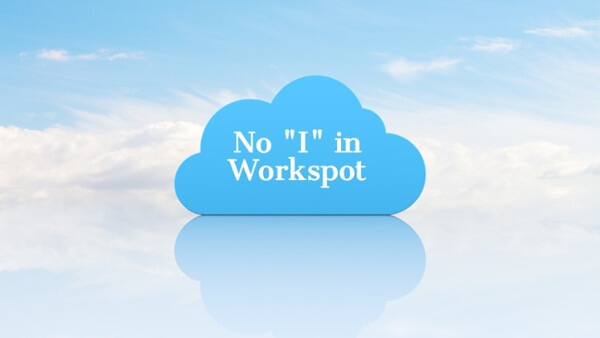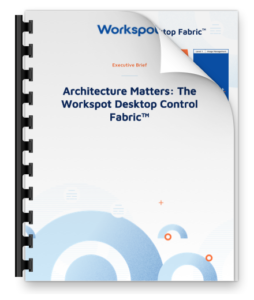There’s No “I” in Workspot (or How VDI Infrastructure is Ruining Your Life)
You’ve heard the phrase, “There’s no I in Team”. This basically means that teams must work together to achieve a goal; no single person can do it alone.
This defines the culture at Workspot and how we work together to make sure our customers are successful with our solutions, but we take it a step further. We say, “There’s no I in Workspot”, and that means that when you work with us to deploy virtual desktops, you’ll never have to “bring your own Infrastructure” (BYOI). We provide your organization “PCs in the Cloud”! Simply decide how many you need and in which of the 54 Azure regions they should live, and we do the rest. With legacy VDI choices, whether cobbled together on-prem or in the cloud, you will always find yourself mired in the complexity and cost of setting up and maintaining infrastructure (servers, networks, storage, databases, etc.). As you rethink virtual desktop solutions, it’s vitally important to understand the difference between turnkey, “born in the cloud”, complete desktop solutions and those that are merely “cloud-enabled” BYOI projects.
These days all kinds of software companies have jumped on the cloud bandwagon – and it’s easy to see why. All you have to do is take a look at some of the surveys by industry analysts to see the huge numbers of organizations that already have a cloud presence or are quickly moving in that direction. Everyday I speak with CIOs and other IT execs who tell me that investing in new data center infrastructure going forward will only be on an exception basis. Many, if not most, see no strategic value to maintaining data center infrastructure, and they are eager to shed the resource overhead required to deal with all that complexity. If you haven’t already, read our blog, “Your Datacenter is Dead, Long Live Azure” for more on this trend. In this day and age of the hyperscale cloud providers underpinning big data, AI and machine learning, IT people and their budgets can be applied to way more valuable analytics projects that can drive new product development, contribute to corporate growth, create competitive advantage, and change lives. So if you can achieve all that, why waste your resources on “keeping the lights on” IT tasks, such as managing data center infrastructure? Why allocate those precious IT resources to micro-manage virtual desktop infrastructure? When you think of it this way, the waste of time and talent really becomes clear. Managing infrastructure just doesn’t make sense anymore. As you take steps to get out of the infrastructure business, you need to drill down on the cloud solutions vendors offer to really understand what your IT team will (and won’t) be responsible for managing.
Born in the Cloud Means Simplicity and More
You see the term “Born in the Cloud” referenced here and there, and we use it to describe Workspot. What do we mean by it, and why does it matter? Techopedia defines it as “a specific type of cloud service that does not involve legacy systems, but was designed for cloud delivery.” Techopedia also notes that born in the cloud products deliver certain benefits, such as “rapid elasticity” and “on-demand availability”. Modern VDI solutions were built from the ground up as cloud services, and there’s only two: Workspot and Amazon Workspaces. Workspot’s enterprise customers require desktop provisioning that happens in minutes, instant scalability, and better-than-physical-PC performance. Those requirements can only be met with a “born in the cloud” solution like Workspot. Those are some pretty compelling benefits, right? But you also get simplicity. If your virtual desktop solution doesn’t simplify your world, it’s time to re-evaluate. These born in the cloud or “cloud-native” virtual desktop and GPU workstation benefits are available to you today, and you should demand them.
Is it Cloud-Enabled or Cloud-Native?
Here are some more terms you need to drill into. When it comes to virtual desktops, the difference between “cloud-enabled” and “cloud-native”- terms that are sometimes used interchangeably and can be easily confused – is VAST. Here is the heart of the matter: A cloud-enabled VDI solution is a legacy product that was originally designed for a traditional data center and was then plunked into the cloud. A cloud-native virtual desktop solution is built from the ground up using micro-services, is multi-tenant, and features fast and easy scalability; it was “born in the cloud”. Cloud-enabled VDI carries with it all the same baggage it had in its data center incarnation: It’s complex, single tenant, and hard to scale. They provide the VDI control plane, although you still have to BYOI, so you’re still allocating those precious IT resources to infrastructure management. The cloud-native solutions deliver all the simplicity, elasticity and scalability benefits I mentioned above. As you shed your ties to IT infrastructure, you have two great choices depending on your specific needs: Workspot and Amazon Workspaces. All the other vendors have cloud-enabled solutions that force you to stay in the infrastructure business, and that will pretty much ruin your life. Here’s why.

Why BYOI Will Ruin Your Life
With any vendor solution other than Amazon Workspaces or Workspot, you’ll need to BYOI. If you’re running your virtual desktops in on-premises infrastructure, it’s all on you to maintain and micromanage your virtual desktop infrastructure (VDI). The challenges with on-prem VDI solutions are widely known; they are complex, costly, and difficult to scale. So you’ll have smart, expensive IT people managing and troubleshooting a whole-bunch-o-infrastructure full-time rather than using their time to help drive product innovation, save lives, and change the world. Hmmmm. Similarly, if you choose a cloud-enabled VDI solution, you guessed it, you’ll still be in the infrastructure business: you have to BYOI, and you’ll still incur the opportunity cost of all those smart people doing unnecessary work. That’s what a cloud-enabled product buys you; the opportunity to plunk down more infrastructure (whether on-prem or in the cloud), that you have to manage and troubleshoot. It’s just as complex to deal with as if you had your virtual desktops on-prem. Without a cloud-native solution, you will miss out on the simplicity benefits.
Lose the “I” in VDI for Business and Personal Transformation
There are good reasons for organizations of all sizes to get out of the business of managing virtual desktop infrastructure. Reallocation of IT resources to more strategic projects, better security, support for mobile work styles, greater agility to serve new markets and as good or better performance than PCs and workstations are just a few reasons why it’s time to go all-cloud. Our customers say it best, “We do not want to be an infrastructure provider; it adds no value”; “Infrastructure has no strategic value for us as a company”; and “We cannot afford the downtime that comes from VDI complexity.” The business benefits of reducing or eliminating IT infrastructure, combined with the opportunity for IT personnel to gain new cloud skill sets and become more strategic players in the organization make for a compelling case for adopting born in the cloud, cloud-native, virtual cloud desktops and workstations.
Find out more about how it works! Schedule a live demo with one of our product experts.




